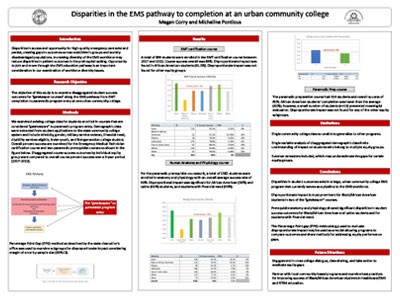ABSTRACTS
Disparities in the EMS Pathway to Completion at an Urban Community CollegeAuthor: Megan Corry, EdD, EMTP, CHSE | | Associate Authors:
Introduction Initiatives to increase diversity of the EMS workforce may reduce disparities in patient outcomes in the prehospital setting. Opportunities to join and move through the EMS education pathway is an important consideration in our examination of workforce diversity issues. Objective To examine disaggregated student success outcomes for “gatekeeper courses” along the EMS pathway from EMT completion to paramedic program entry at one urban community college. Methods We examined existing college data for students enrolled in EMS courses. Demographic data were extracted from student applications to the state community college system and include ethnicity, gender, veteran status, financial need, foster youth, and first-generation college student. Percent success for EMT, and two paramedic prerequisite courses were examined by individual group and compared to average outcome over a 5-year period (2017–2022). The percentage point gap (PPG) method as described by the state chancellor’s office was used to examine subgroups for disproportionate impact considering the margin of error by sample size (95% CI). Results A total of 856 students were enrolled in the EMT course between 2017 and 2022. Course success overall was 84%. Disproportionate impact was found in African American students (61.5%). No disproportionate impact was noted for other equity groups. For the paramedic prerequisite coursework, a total of 1,382 students were enrolled in anatomy and physiology with an overall average success rate of 69%. Disproportional impact was significant for African American (39%) and Latinx (61%) students and students financial need (65%). The paramedic preparation course had 416 students and overall success of 81%. African American students’ completion was lower than the average (61%); however, the small number of students (n = 13) prevented meaningful evaluation. Disproportionate impact was not found for any of the other equity subgroups. Conclusions Disparities in student outcomes exist in a large, urban community college EMS program that currently serves as a pipeline to the EMS workforce. The methodology used to evaluate disproportionate impact may be used as a model so EMS programs can compare outcomes and share methods for addressing equity performance gaps, especially for African American and Latinx students entering EMS programs.
|

